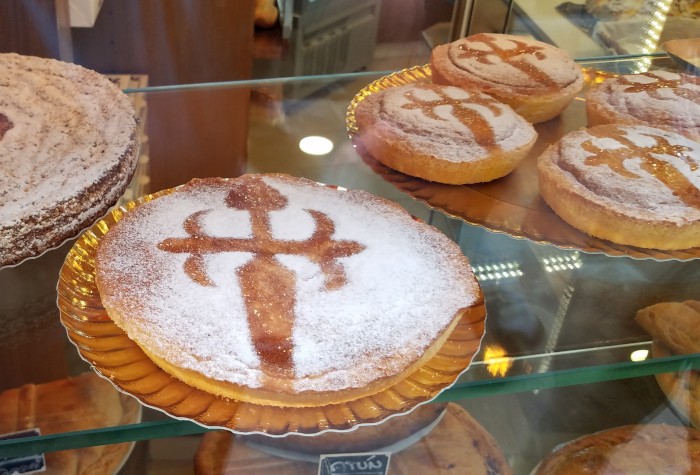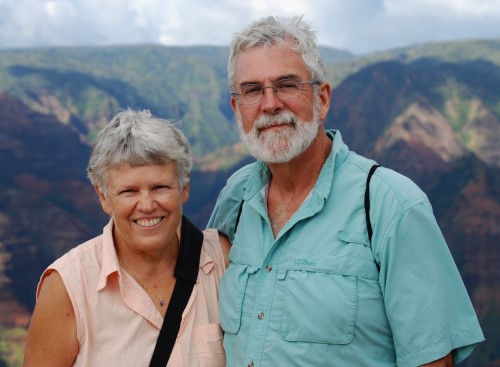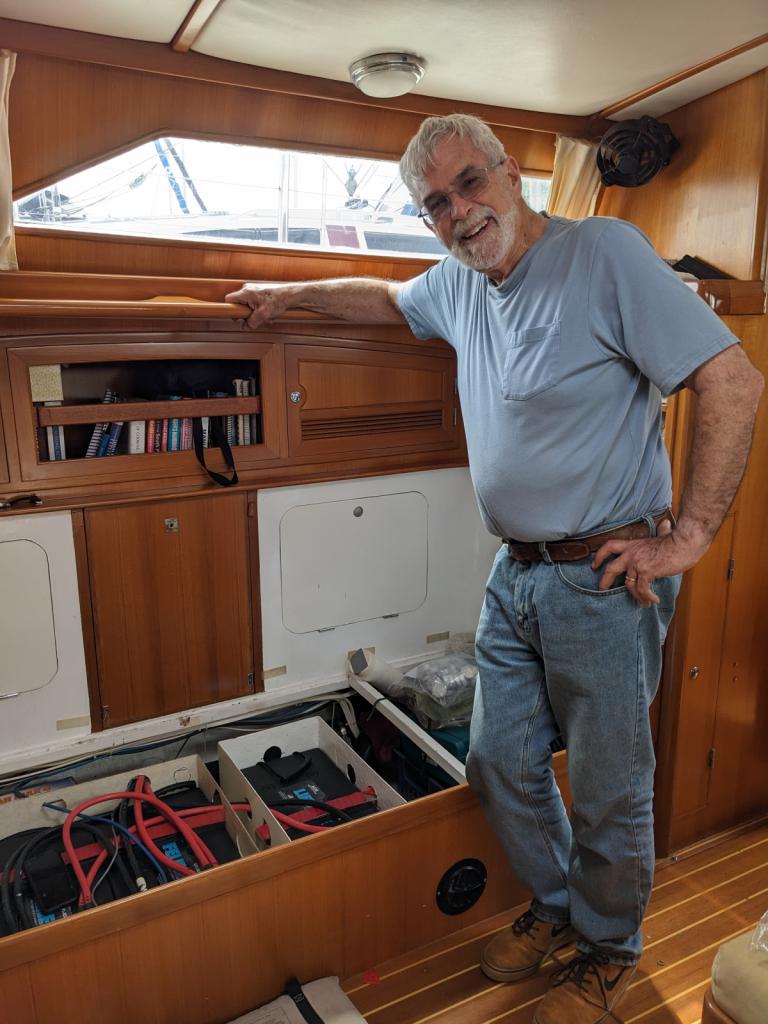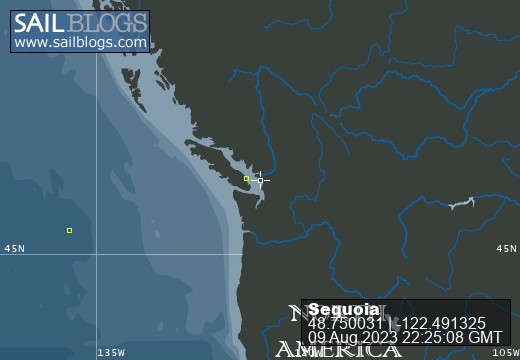
Sequoia Changing Latitudes
30 August 2023 | St. Helens, Oregon
09 August 2023 | Bellingham, Washington
21 July 2023 | Boat: Bellingham; C&B: Scappoose
10 July 2023 | Egmont, Sunshine Coast, B.C., Canada
02 July 2023 | Walsh Cove, Desolation Sound, B.C., Canada
23 June 2023 | Westview/Powell River B.C.
18 June 2023 | Ganges, Saltspring Island, B.C., Canada
22 June 2019 | Scappoose, Oregon
27 May 2019 | Back home in Oregon
09 May 2019 | Villas Alturas Hotel, Costa Rica
02 May 2019 | San Vito, Costa Rica
23 April 2019 | Golfito, Costa Rica
11 April 2019 | Panama City, Panama
04 April 2019 | Shelter Bay Marina, Colon, Panama
22 March 2019 | Jamaica
11 March 2019 | Zar Par Marina, Boca Chica, Dominican Republic
18 February 2019 | Culebra Island, Puerto Rico
31 January 2019 | Simpson Bay Lagoon, Sint Maarten
21 January 2019 | Nelson's Dockyard, English Harbour, Antigua
04 January 2019 | Portsmouth, Dominica
Traveling in Galicia with the Pilgrims of the Way
28 July 2018 | Muros, Galicia, Spain
Barbara/Sunny in the Afternoon

Along the west coast of Galicia (Spain's northwest province) there are a series of inlets, called Rias in the native Galician language. Each one seems to have a collection of interesting communities, most being fishing villages (at least originally). These days there is a fairly high reliance on tourism, in its various land-based and ocean-based forms, although there are still plenty of fishing boats, plenty of seafood for sale in the local markets and roadside stands, and many restaurants featuring mariscos (seafood). Beaches abound, well populated with playing, swimming and bronzing people. Most mornings there is fog from the ocean, but by late morning it burns off. By late afternoon, it's typically quite hot. Above: The beach at Muros.
Above: The beach at Muros.
Each of the Rias seems to have plenty of well-protected harbors - either anchorages or dedicated harbors and marinas. The marinas are often built within the sea walls of an old harbor. Sea walls fully visible at low tide have layers of different sorts of stones and construction techniques. It's easy to imagine that the bottom layers may have been put there by the Romans in the 3rd century AD.
The coast west of A Coruña is called the "Costa da Morte" (Coast of Death) on account of the multiple shipwrecks which have occurred here. There are local legends of people who would put out deceptive lights to lure ships onto the rocks, in order to be able to plunder their cargo. By contrast, we found it to be a very benign coast, but then we always wait for the best possible weather. I'm sure sailing in winter is another thing altogether.
The area is suffused with the presence, not far off in the center of Galicia, of the Cathedral of Santiago de Compostela. Pilgrimages ("the Way") to the tomb of St. James at the Cathedral are always in evidence. Bakeries sell pastries stenciled with powdered sugar using symbols of the Cathedral. (See photo at the top of this post). The scallop shell emblem that symbolizes the Way appears often in local artwork and signage. Small chapels abound with references to the pilgrimages. Yesterday we visited a 15th century chapel in Muros dedicated to La Virxe do Camiño (the Virgin of the Way).
Above: the interior of the Sanctuary of Virxe do Camiño, cleaning underway?
Also yesterday, a flotilla of sailboats arrived in the marina bearing religious flags, with scallop image and the motto, "Navega el Camino 2018." (Sail the Way 2018). It turns out this is another means of completing "the Way". The boats that arrived here yesterday had sailed to a succession of 11 marinas across the north coast of Spain, then around the northwest corner to Muros (where we now are). Tomorrow, the participants "walk" to the Cathedral (60 kilometers distant), although it turns out the sponsors provide a bus for the middle 50 kilometers. There, at the pilgrimage office, if you have completed all necessary steps, you can get your piece of paper ("La Compostela") certifying that you've completed the pilgrimage. Today, on the eve of their completion of The Way, the sailing pilgrims seem to be having a very good time. As I write, there appears to be a competition in the blowing of conch shells.

Above: The flags of some participants in the sailing pilgrimage
Before we left A Cornuña we said good-bye to Jamie and Eleanor, who had helped us with the crossing of the Bay of Biscay. We spent a couple more days there, waiting for a north wind to continue west then south around the corner of Spain. We went back to a favorite restaurant, Taberna del Chipirón, and ordered our by-then favorites Pulpo a la Feiria (octopus, fair-style), Chipirones a la Plancha (grilled squid) and Pimientos al Padrón (small sweet green peppers, fried and salted).

Above: Dinner at the Taberna del Chipirón
We bicycled out to the north of town on an excellent bike path, and climbed up the hill to Hercules' Tower - a lighthouse that is reportedly built on the foundations of the oldest lighthouse ever - erected by the Romans at the western edge of civilization.
The marina in A Coruña is located next to the downtown esplanade - a wide pedestrian plaza backed up to the harbor-front street which is in turn lined with tall mid-century apartment buildings. Since we had arrived, they were setting up for a weekend street fair called "StreetStunts". Two big climbing walls were erected, including one slanted out over the water. There was a parkour obstacle course being set up, a large floor for gymnastics floor exercises, a trampoline, a tightrope being used for trampoline-type moves, several performance stages and a plethora of Estrella beer stands and food carts.

Above: StreetStunts fair adjacent to the A Coruña harbor.
It was fun to watch the various activities and athletic endeavors, but we feared what might be coming from those performance stages. Indeed, by Friday evening there was a great thumpa-thumpa which could not be escaped from even inside our boat with all the hatches battened down tight. The next morning we moved the boat to a marina about a mile away, prior to our planned departure on Sunday, when the winds were predicted to be good.
We went first to Camariñas, in one of the first Rias west of A Coruña. The little town climbs up a hillside, and interesting sights are promised in every direction. We set off several times on our bikes but found the maps didn't quite match up with what we saw, and some unsigned turns that appeared to be public roads were, in fact, someone's driveway. Or "the road" turned into a dirt path, and we find ourselves unwilling to test our brand new Bromptons on a path of unknown bumpiness and dustiness. In town we found the ice cream stand and the local "supermarket" (somewhat closer in feel to a corner store).
We tried the restaurant in the marina, filled with local vacationers, and had our first paella, bubbling away as it was set down on our table, filled with tiny clams, squid and shrimp.

Above: Paella in Camariñas.
The marina was filled with French boats, and as we sat in the restaurant, we watched another one come in. This one was in trouble, apparently unable to furl their mainsail in 20 knots of wind. They had untied the back end ("clew") of the sail from the boom and tied it forward to the mast, but most of the sail was still out catching wind, and making the docking a disaster about to happen. All the other French sailors, and Craig, ran down to provide help, but it turned out that not speaking fluent sailor-French was a real handicap. They got the boat tied up, and then fussed for several hours, into the dark, trying to get the sail under control. The boat had an in-mast furling system, which requires real precision to get the sail to furl properly. The boat did not have a bosun's chair (system for climbing the mast), but they were able to borrow one from another boat. After considerable time aloft, they were able to sort out the problem and the mainsail was finally rolled into the mast.

Above: Problems with in-mast furling, Camariñas
This all confirms Craig's conclusion that in-mast furling systems, if not carefully managed, can be a recipe for disaster. If they work well, they can make sail management much easier, but the possible downside is pretty bad. Because of rolling on the vertical, they lack the horizontal battens which help force the sail into an efficient airfoil profile.
From Camariñas we watched the forecasts for the next good wind for heading around Cape Fisterra (Cape Lands' End), longitude 9°W, more than 500 miles west of the Greenwich Meridian, the furthest west point of Continental Europe.
If you head south around Cape Fisterra into a south wind, there is apparently the risk of big confused waves around the cape. When the good forecast came, we headed out into the fog, radar at the ready, and continued west and then south. Cape Fisterra is a knife-edge ridge jutting out into the ocean, with a lighthouse and a church perched on top. Apparently that church is sometimes the final destination of the Santiago de Compostela pilgrims. A friend told me that it also has a different but still spiritual significance for the Roma people.

Above: Cape Fisterra
So that brings us around to where I started this blog - in the harbor at Muros. Here we're dealing with some pesky boat problems, but also enjoying the town and the beautiful surroundings.
All the best to friends and family at home and along the way.
Craig & Barbara
S/V Sequoia
If you'd like to see more photos corresponding to this blog post, check out our Flickr album.
 Above: The beach at Muros.
Above: The beach at Muros.Each of the Rias seems to have plenty of well-protected harbors - either anchorages or dedicated harbors and marinas. The marinas are often built within the sea walls of an old harbor. Sea walls fully visible at low tide have layers of different sorts of stones and construction techniques. It's easy to imagine that the bottom layers may have been put there by the Romans in the 3rd century AD.
The coast west of A Coruña is called the "Costa da Morte" (Coast of Death) on account of the multiple shipwrecks which have occurred here. There are local legends of people who would put out deceptive lights to lure ships onto the rocks, in order to be able to plunder their cargo. By contrast, we found it to be a very benign coast, but then we always wait for the best possible weather. I'm sure sailing in winter is another thing altogether.
The area is suffused with the presence, not far off in the center of Galicia, of the Cathedral of Santiago de Compostela. Pilgrimages ("the Way") to the tomb of St. James at the Cathedral are always in evidence. Bakeries sell pastries stenciled with powdered sugar using symbols of the Cathedral. (See photo at the top of this post). The scallop shell emblem that symbolizes the Way appears often in local artwork and signage. Small chapels abound with references to the pilgrimages. Yesterday we visited a 15th century chapel in Muros dedicated to La Virxe do Camiño (the Virgin of the Way).

Above: the interior of the Sanctuary of Virxe do Camiño, cleaning underway?
Also yesterday, a flotilla of sailboats arrived in the marina bearing religious flags, with scallop image and the motto, "Navega el Camino 2018." (Sail the Way 2018). It turns out this is another means of completing "the Way". The boats that arrived here yesterday had sailed to a succession of 11 marinas across the north coast of Spain, then around the northwest corner to Muros (where we now are). Tomorrow, the participants "walk" to the Cathedral (60 kilometers distant), although it turns out the sponsors provide a bus for the middle 50 kilometers. There, at the pilgrimage office, if you have completed all necessary steps, you can get your piece of paper ("La Compostela") certifying that you've completed the pilgrimage. Today, on the eve of their completion of The Way, the sailing pilgrims seem to be having a very good time. As I write, there appears to be a competition in the blowing of conch shells.

Above: The flags of some participants in the sailing pilgrimage
Before we left A Cornuña we said good-bye to Jamie and Eleanor, who had helped us with the crossing of the Bay of Biscay. We spent a couple more days there, waiting for a north wind to continue west then south around the corner of Spain. We went back to a favorite restaurant, Taberna del Chipirón, and ordered our by-then favorites Pulpo a la Feiria (octopus, fair-style), Chipirones a la Plancha (grilled squid) and Pimientos al Padrón (small sweet green peppers, fried and salted).

Above: Dinner at the Taberna del Chipirón
We bicycled out to the north of town on an excellent bike path, and climbed up the hill to Hercules' Tower - a lighthouse that is reportedly built on the foundations of the oldest lighthouse ever - erected by the Romans at the western edge of civilization.
The marina in A Coruña is located next to the downtown esplanade - a wide pedestrian plaza backed up to the harbor-front street which is in turn lined with tall mid-century apartment buildings. Since we had arrived, they were setting up for a weekend street fair called "StreetStunts". Two big climbing walls were erected, including one slanted out over the water. There was a parkour obstacle course being set up, a large floor for gymnastics floor exercises, a trampoline, a tightrope being used for trampoline-type moves, several performance stages and a plethora of Estrella beer stands and food carts.

Above: StreetStunts fair adjacent to the A Coruña harbor.
It was fun to watch the various activities and athletic endeavors, but we feared what might be coming from those performance stages. Indeed, by Friday evening there was a great thumpa-thumpa which could not be escaped from even inside our boat with all the hatches battened down tight. The next morning we moved the boat to a marina about a mile away, prior to our planned departure on Sunday, when the winds were predicted to be good.
We went first to Camariñas, in one of the first Rias west of A Coruña. The little town climbs up a hillside, and interesting sights are promised in every direction. We set off several times on our bikes but found the maps didn't quite match up with what we saw, and some unsigned turns that appeared to be public roads were, in fact, someone's driveway. Or "the road" turned into a dirt path, and we find ourselves unwilling to test our brand new Bromptons on a path of unknown bumpiness and dustiness. In town we found the ice cream stand and the local "supermarket" (somewhat closer in feel to a corner store).
We tried the restaurant in the marina, filled with local vacationers, and had our first paella, bubbling away as it was set down on our table, filled with tiny clams, squid and shrimp.

Above: Paella in Camariñas.
The marina was filled with French boats, and as we sat in the restaurant, we watched another one come in. This one was in trouble, apparently unable to furl their mainsail in 20 knots of wind. They had untied the back end ("clew") of the sail from the boom and tied it forward to the mast, but most of the sail was still out catching wind, and making the docking a disaster about to happen. All the other French sailors, and Craig, ran down to provide help, but it turned out that not speaking fluent sailor-French was a real handicap. They got the boat tied up, and then fussed for several hours, into the dark, trying to get the sail under control. The boat had an in-mast furling system, which requires real precision to get the sail to furl properly. The boat did not have a bosun's chair (system for climbing the mast), but they were able to borrow one from another boat. After considerable time aloft, they were able to sort out the problem and the mainsail was finally rolled into the mast.

Above: Problems with in-mast furling, Camariñas
This all confirms Craig's conclusion that in-mast furling systems, if not carefully managed, can be a recipe for disaster. If they work well, they can make sail management much easier, but the possible downside is pretty bad. Because of rolling on the vertical, they lack the horizontal battens which help force the sail into an efficient airfoil profile.
From Camariñas we watched the forecasts for the next good wind for heading around Cape Fisterra (Cape Lands' End), longitude 9°W, more than 500 miles west of the Greenwich Meridian, the furthest west point of Continental Europe.
If you head south around Cape Fisterra into a south wind, there is apparently the risk of big confused waves around the cape. When the good forecast came, we headed out into the fog, radar at the ready, and continued west and then south. Cape Fisterra is a knife-edge ridge jutting out into the ocean, with a lighthouse and a church perched on top. Apparently that church is sometimes the final destination of the Santiago de Compostela pilgrims. A friend told me that it also has a different but still spiritual significance for the Roma people.

Above: Cape Fisterra
So that brings us around to where I started this blog - in the harbor at Muros. Here we're dealing with some pesky boat problems, but also enjoying the town and the beautiful surroundings.
All the best to friends and family at home and along the way.
Craig & Barbara
S/V Sequoia
If you'd like to see more photos corresponding to this blog post, check out our Flickr album.
Comments
| Vessel Name: | Sequoia |
| Vessel Make/Model: | Outbound 44 |
| Hailing Port: | Portland, Or |
| Crew: | Craig & Barbara Johnston |
| About: | |
| Extra: |
Sequoia's Photos - Main
Who we are...

Who: Craig & Barbara Johnston
Port: Portland, Or



